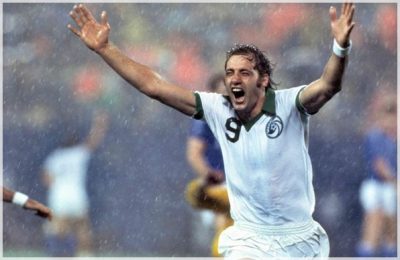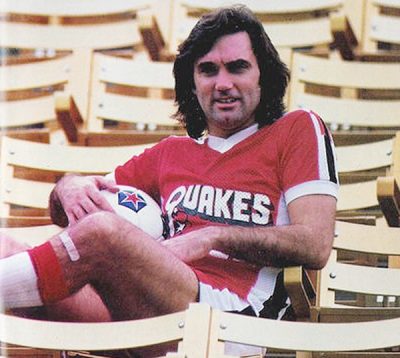On a cool, foggy morning in Point Loma, I sat down for coffee with Manny Neves. The color of his slicked back hair was reminiscent of the sky outsi
On a cool, foggy morning in Point Loma, I sat down for coffee with Manny Neves.
The color of his slicked back hair was reminiscent of the sky outside, this sharp-witted silver fox sipping his java while sharing stories and enlightening me with an endless supply of footballing philosophy.
Neves is a soccer romantic. A native of Pico in the Portuguese Azores, he moved with his family to La Mesa when he was 10. He’s seen San Diego as his home ever since.
As a professional, he played in the old North American Soccer League in the late ’70s and early ’80s, suiting up for the California Surf against the likes of George Best and Giorgio Chinaglia, men who carry more clout postmortem than most living footballers could ever dream of holding.
As fond as he is of his playing past, Neves loves what the game has offered him long past his retirement from the pitch. As a Director of Coaching, he pours his heart and soul into Coronado Soccer Club, and though he lives a mainland San Diego life, his spiritual home is most certainly “on the island”, where he spends a significant portion of every passing day.
We sat and sipped coffee for well over two hours. I soaked in as much of our conversation as I possibly could, continuously jotting down words and quotations, writing and recording as the golden bits of wisdom and nostalgic tales poured out with an effervescent flow.
Here’s some of the finer lines from a memorable and engaging encounter.
(On why smaller players tend to be more skillful…)
Neves: “When you’re a little guy, you gotta be different. The little guy has to be a special player. One of my first soccer coaches when I moved to America taught me about this. His name was Mr. Patterson. He encouraged me to continue using a tennis ball the way I had back in Pico, to focus on my touch more than anything. I was never going to be able to match-up physically with a lot of players. But I knew I could beat them by having more skill. There’s a certain little guy from Argentina, who plays for Barcelona, who comes to mind in this regard.”
(On the unique set of circumstances faced by Coronado Soccer Club…)
Neves: “Coronado is such a unique place. For our soccer club, you have lots of kids who are part of military families. They are likely only going to be there for 2-3 years, and then they’re gone. And 75% of our players have to come from the island. Bigger clubs in the area don’t face the same restrictions. They can pick from anywhere! How do you compete with that?”
“For me, the answer is to put together the best possible coaching staff and utilize our incredible facility. I would put our coaching staff and our facility (the Coronado Cays) up against any others in this area. We might face a difficult set of rules and regulations, but we will never let that be an excuse for not giving everything to these young people.”
(Speaking on the “buzz words” of youth soccer…)
Neves: “We always hear that word development. Do people really know what it means?”
“First it was development. Then we started hearing the word ‘premier‘. Then clubs started using ‘elite‘ in their names. Then came the buzz of the academy system. It can really just be a play sometimes. And so often, I feel like parents put more stock into these words than they do effort in actually trying to understand how they are being applied. They’re just buzz words.”
“Now of course I’ve got my own key word, and it holds a very deep meaning. It’s ‘technique’. For me, there is no more important word in coaching, especially when we are talking about kids ages 6-12. Proper technique for each individual should be the number one focus of all coaches. It’s what kids need most at that stage. Once they reach the teenage years, then it is time to teach them the tactical side of the game, and really emphasize the importance of decision making. By the time these young men and women are turning 16, 17, 18, they need to know the game inside and out, and be able to make quick decisions. It all starts with the base they establish as children. It all comes back to the technique.”
(On the importance of young players valuing the “beautiful game”, not just winning…)
Neves: “One of the simplest and yet most beautiful things in the game of soccer, at any level, is the wall pass. It symbolizes a certain commitment, a desire to help a teammate get out of a dangerous situation, a selfless act you could say. I also feel the same way about overlapping runs. The overlap is such a great concept. I’m going to pour my energy into this one moment to draw attention to myself, in turn allowing you to take someone on with a higher chance of success. Or if the pass is on, you can play the ball onto the overlapping run. It’s really special to think of these little things within the game as acts of devotion, teamwork, and selflessness.”
“I have a rule with all my teams. A wall pass in a game is 10 push-ups for me. An overlap is 10 push-ups. A split is 10 push-ups. These things, for young teams, are more important than the final score. I want kids to understand and appreciate how beautiful this game can be when it’s played the right way. If a team I’m coaching loses a game, but they make me do 100 push-ups, I’m the happiest coach in the world. Sore, but very happy.”
(Speaking of the term ‘ball-hog’, and the negativity towards young players who seldom pass…)
Neves: “I remember being out last year at a little kids event, U-6 soccer. They were playing little 4 v. 4 games, which would often turn into 1 v. 7. People around would start talking about the one kid with the ball, calling him or her a ‘ball-hog’. It was crazy seeing people say this about little kids, but I see it in competitive older levels too, people being so resentful of the players that don’t pass. I understand the resentment. It can be frustrating to play with someone that doesn’t want to pass the ball.”
“But as a coach, when I see a kid like that, all I’m thinking is ‘great!’ I immediately know that this kid has the desire and courage to take people on, to make mistakes, learn from them, and then come back for more. When I see a ‘ball-hog’, I see a kid with creative potential that knows how to help themselves, a strong independent soccer mind. As a coach, it’s on me at that point to help that kid realize that they can also create for other people, that the great pass can be just as cool and rewarding as the flashy dribble. I want to show that kid that they can help everyone around them with their skill.”
“Youth soccer is so often too structured for my taste. I see players at the high school level who look rigid and robotic because they’ve been in these systems for so long. Young players should have a certain level of freedom, a freedom of artistic expression and a freedom to make mistakes. That freedom, and those mistakes, is what helps young players learn how to make their own decisions in split-second situations later on in their careers. That freedom helps them become students of the game, people capable of analyzing the details of soccer. It also makes for a more entertaining brand, the way the beautiful game should be played.”
(Thoughts on the “family of fakes”, a footballing ideal akin to something from a Kung-Fu master…)
Neves: “When it comes to skill-moves, you have nine traditional fakes in soccer. I call them the family of fakes. You have your set of body fakes, your cuts, and your changes of speed. Every player must have at least three or four of these to be successful. If a player wants to be an attacking presence at a high level of the game, I feel that they need to master at least six different fakes. If you master all nine, and utilize them against your competition, you are a world class player, and you must use your skill wisely.”
“You must become one with the ball. I want young kids to learn the game through the ball, to become one with the soccer ball. Know it. Master it. Be one step ahead of the ball at all times, while also embracing everything it can do for you. As a soccer player, the ball is your greatest tool.”
(Memories of playing on the same professional pitches as football legends Giorgio Chinaglia and George Best…)
Neves: “Bestie was one of the craftiest players in the world. One time with California Surf, while Best was playing with the San Jose Earthquakes, we told our keeper how he always cut in from the left side and shot far-post with his right foot. A little ways into the game, one of those situations occurred. Our keeper (a well known and highly respected goalie named Alan Mayer) took a little cheat step toward his left post. In the blink of an eye, moving in-field at full speed with the ball at his feet, Best somehow released this missile of a shot back to the near post. It went in and Mayer was left flat footed. I’m not gonna lie, we all laughed. We’d told Alan all week what to do in that situation, he did it, and Best made him and all of us look like fools. I’ll never forget that goal.”
“Giorgio Chinaglia was someone who I feel could play in any era of soccer and in any country in the world. He just had a way about him that was universally great. Defenders hated him, because you could honestly do everything fundamentally right and he’d still beat you. I can’t tell you how many times I watched Giorgio take a shot from distance when no other player would dare. There would sometimes be two defenders standing right in front of him. You’re thinking, how the heck does he think he’s gonna get this shot off.”
“An interesting skill that I picked up from watching Giorgio was how to use defenders as visual screens, messing with the goalkeepers mind by allowing defenders to stay in front of you and still shooting. He was not the fastest player in the world, and he knew that he probably wasn’t gonna beat you for pace. So Giorgio would use these little quick bursts to get shots away. He would shoot between defenders legs all the time! Chinaglia probably had more deflected goals than any player in the NASL, but he didn’t care. They still counted just the same, and he scored in bunches.”

(A brash arrogance and an unwavering desire to win and humiliate his opponents made Chinaglia a polarizing figure, and a true legend.)
“In 1980, we played the New York Cosmos and the game was on national television. It was one of the only times that our California Surf team was featured on national TV. I’ll never forget being 1 v. 1 with Chinaglia in that game. He tried to meg me, and I stood him up, and took the ball off his feet, heading the other way as he fell to the floor. You don’t think about it at the time, but that’s a great story. A lot of people might not believe it. It’s a bummer I don’t have that tape. Maybe we could find it somewhere?”

